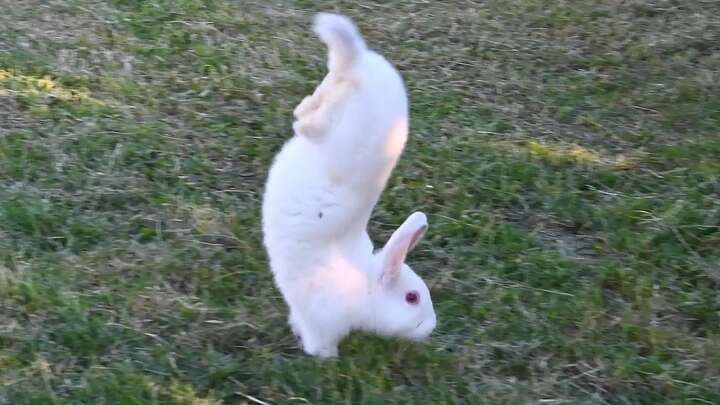For over a century, animal experts have known that a certain variety of rabbits move exclusively on their front legs when trying to move fast, but they’ve only recently learned why that is.
The Sauteur d’Alfort, also known as the Alfort jumping rabbit have baffled scientists for more than a decade. Unlike other rabbit varieties, the sauteur d-Alfort have a uniquely acrobatic way of moving. Over short distances, when moving slowly, they walk on all four limbs, but their hind legs hit the floor one after another, rather than at the same time. But the truly remarkable thing happens when it needs to move faster. Rather than hopping, it quickly lifts its hind legs above its head and starts moving on its front legs alone. Experiments done decades ago showed that the sauteur was incapable of hopping, but thanks to modern technology, scientists know exactly why that is.

Photo: video screengrab
Experiments conducted as far back as 1943 showed that the inability to hop displayed by the sauteur d’Alfort rabbit was not a learned behavior, but the result of a recessive gene. However, until recently, no one knew exactly what gene that was, or how it prevented the animal from doing what all other rabbits find perfectly natural.
“With modern technology, it’s straightforward to go from a simple recessive disorder to finding the genes,” Leif Andersson, a geneticist at Uppsala University in Sweden, told Gizmodo. “The expectation was there was something wrong with the spinal cord, because they don’t coordinate their forelegs and the hind legs.”
That expectation proved correct, as a study conducted by scientists at Uppsala University shows that a warped gene called RORB (RAR-related orphan receptor beta) rendered them incapable of jumping. RORB helps pass information and links the left and right side of the body – which is essential for coordinating limb movements – but the warped gene caused the rabbits to over-flex their hindlegs, making jumping impossible.
“What’s happening when you’re moving is that you have these neurons firing all the time, and they coordinate muscle contractions and receive feedback on the balance of the different limbs,” Andersson said. “This coordination of muscle contraction is not correct in these rabbits.”
Basically, the handstand movement of certain sauteur d’Alfort rabbits is not itself the mutation, but rather a workaround to a debilitating genetic condition that prevents them from doing the iconic hop. Andersson added that the front-legged means of locomotion causes the rabbits no pain of which he was aware.
While the solving of the puzzle that was the sauteur d’Alfort movement may not seem like a scientific breakthrough, experts say that it is a testament to how far genetic science has come in recent years, and could advance our understanding of how vertebrates can walk.












